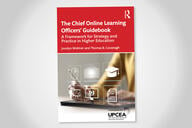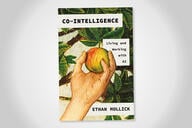You have /5 articles left.
Sign up for a free account or log in.
Tawnya Means is the assistant dean for educational innovation at the Gies College of Business at the University of Illinois at Urbana-Champaign. You might know Tawnya through her frequent (and excellent) writing on AI and higher education innovation. A sample of these articles include:
- At the Threshold: Higher Education in the Imminent AGI Era
- Amplified Humanity: How AI Can Expand Our Capacity to Do Good and Be Good
- Rethinking Risk: The Cost of Action vs. Inaction in Higher Education
- AI as a Visionary Tool: Enhancing Perception in Learning, Work and Life
- The Dual Transformation Imperative: How Higher Education Can Thrive in the AI Era
- Embracing AI for Innovation: Unlocking Human Potential
- What Does It Mean to Be Human? Navigating the Changing Role of Educators in the Age of AI
I asked if Tawnya would be willing to answer my questions about her work and her thinking about AI and higher education, and she graciously agreed.

Q: Tell us about your current role. What projects and initiatives do you work on? What should those in the academic innovation field know about the University of Illinois and the Gies College of Business? And while we are talking about your current role, can you also share the educational and career path that brought you to your current position?
A: In my current role as assistant dean for educational innovation, I lead organizational transformation initiatives at the intersection of pedagogy, technology and strategic innovation. Over the last several years, I’ve scaled a dynamic teaching and learning team in the college from approximately 20 to 60 incredible professionals dedicated to educational change and innovation. A significant focus of my work was continuing to support the great work of innovation in Gies’s online graduate programs, which have been widely recognized for their approach to business education—maintaining academic rigor while dramatically increasing accessibility and affordability at scale. My most recent work encompasses frameworks for orchestrating comprehensive change management strategies for digital and AI initiatives while developing operating models and frameworks that facilitate sustainable transformation across the institution.
My current projects span multiple domains of impact in higher education. I’m developing frameworks for understanding and implementing AI in education, mentoring universities participating in the AAC&U’s AI and Pedagogy Institute and serving as an adviser on curriculum, pedagogy and student experience for an AI-driven institute. I’ve also been delivering webinars and workshops on AI applications in teaching, learning and organizational strategy while simultaneously supporting the development of educational technologies that enhance AI-supported teaching and improve accessibility.
In the academic innovation field, I’ve found that the most effective approach centers on creating a genuine culture of innovation rather than treating innovation as a siloed initiative. This means embedding experimentation throughout operations, encouraging calculated risk-taking and maintaining a relentless focus on learner outcomes while using robust data analytics to continually assess and refine programs. It also means valuing time to learn and grow, providing psychological safety for experimentation and failure and maintaining human compassion and cultivating strong relationships.
My career path has developed progressively, bringing me a comprehensive view of educational transformation. With 18-plus years of higher education experience, I began with strong academic preparation in educational practice and educational technology, which gave me a solid theoretical foundation in how the integration of pedagogy and technology can transform learning environments.
After earning my doctorate in information science and learning technologies, with my dissertation focusing on lifelong learning and digital resources, I have held administrative leadership and teaching faculty positions in well-respected business colleges, teaching entrepreneurship, management and strategy. I built and led teaching and learning centers at the University of Nebraska at Lincoln and the University of Florida, helping faculty in online, blended and in-person modalities integrate technology into their teaching.
In addition, my 13-plus years of consulting work with over 25 institutions have given me valuable perspectives on managing change in complex organizational environments with multiple stakeholder groups and competing priorities. This blend of academic preparation, leadership experience and consulting work has uniquely positioned me to address the challenges and opportunities at the intersection of education and emerging technologies, especially at this time of unprecedented change.
Q: Let’s talk about AI. I’ve linked to some of your writing on AI and innovation, but I’m hoping you might synthesize some of your thinking. If you had the opportunity to get in an elevator with a college president, what would you tell them about how AI could change their institution?
A: Drawing from my experience experimenting with, thinking about and leading AI change at the University of Illinois over the last two and half years, as well as consulting with multiple institutions about their work in AI, I would emphasize three key points:
- First, AI represents both the most significant challenge and the most exciting opportunity that higher education has faced in generations. It’s not merely a new technology to adopt but a fundamental shift that will transform how we teach, learn, research and operate. My exposure across a cross-section of institutions has shown that every aspect—from curriculum and pedagogy to student services and administrative functions—must be reimagined in light of AI capabilities. The institutions that thrive will be those that develop a comprehensive, strategic approach to AI integration rather than treating it as a peripheral concern.
- Second, AI necessitates a dual-transformation approach. Throughout my learning and experience in business strategy, as well as consultation work imagining and designing change management for technological transitions, I’ve found that we must simultaneously optimize our current educational models while building entirely new paradigms. The mistake many institutions make is focusing exclusively on either defending traditional approaches or chasing radical innovation. The reality is that we need both: thoughtful integration of AI into existing programs to enhance their effectiveness alongside bold experiments in new educational models that leverage AI’s unique capabilities. I’ve facilitated strategic visioning workshops that create institutional structures supporting both incremental improvement and disruptive innovation.
- Third, AI will fundamentally shift our value proposition as educational institutions. When information and basic cognitive tasks are instantly accessible through AI and we experience a tsunamic impact of job shifts that require reskilling and upskilling, our true value lies in giving learners the education they need in smaller and immediately applicable chunks, while also developing their distinctly human capabilities—critical thinking, ethical reasoning, creative problem-solving, emotional intelligence and collaborative leadership.
Through my AI-driven educational initiatives, I’m helping institutions reorient their curriculum, pedagogy and assessment around these higher-order capacities while leveraging AI to handle more routine aspects of teaching and learning. My approach combines technological expertise with a deep understanding of the human elements of change, ensuring AI implementations are both technically sound and enthusiastically adopted. I strongly believe that AI can help us to be better at being human and doing great good in the world.
In essence, AI isn’t simply a technological challenge—it’s a catalyst for reimagining the purpose and practice of higher education in the 21st century. Through my work with dozens of institutions, I’ve seen firsthand that leaders who recognize this fundamental reality and implement data-driven approaches to measure transformation ROI will position their institutions not just to survive this transition but to lead it. I would emphasize the need for leadership and vision in the changes that need to be made.
Q: I’d like to explore AI and universities by focusing on online learning. Can you share some specific ways that AI might increase the productivity of online course/program development and running? How might schools leverage AI to drive down student costs and broaden enrollment?
A: Through my work in my current role as well as in bringing AI-enabled educational technologies to market and advising institutions on AI integration, I’ve identified several specific ways AI offers transformative potential for online learning productivity while simultaneously improving quality and reducing costs:
For course development, AI can dramatically accelerate content creation while enhancing quality. In the Gies College of Business Teaching and Learning Center, learning designers are learning to use AI to generate initial drafts of learning objectives, assessments and course materials, allowing faculty to focus on refining and customizing rather than starting from scratch.
Faculty are exploring the use of AI to develop videos, make their content more accessible and give feedback and assessment support to their students. We can see reductions in development time for new online courses when AI is thoughtfully integrated into the workflow. In the many workshops and webinars that I deliver, I help educators see how they can implement AI-assisted course design tools to quickly transform domain expertise into structured learning experiences, potentially reducing development cycles from months to weeks.
In course delivery and facilitation, I’ve guided the development of AI-powered teaching assistants that are revolutionizing student support. These systems provide 24-7 personalized assistance, answering routine questions, offering formative feedback on assignments and identifying students who may need additional help from human instructors. In another consulting project, I am helping enrollment advisers evaluate and integrate AI tools that streamline workflows, reduce bottlenecks and help advisers connect in more supportive, student-focused ways while also reducing response times and improving student satisfaction.
My work with AI-enhanced assessment tools has shown that AI enables both efficiency and deeper learning. I’ve helped integrate automated grading systems that have evolved beyond multiple-choice questions to thoughtful evaluation of written assignments, code and even design projects, with faculty providing oversight and handling edge cases. I have seen how accessibility needs can be met more comprehensively and with less effort in minutes rather than months. I’ve advised multiple institutions on systems that generate personalized feedback at scale, helping students understand not just what they got wrong, but why and how to improve—something impossible to deliver consistently with human resources alone. These systems help relieve student anxiety around assessments and give them valuable, timely, fair and consistent feedback to improve their learning.
Regarding cost reduction and enrollment expansion, I have identified several approaches showing promise:
- Dynamic content development models: In workshops I’ve conducted on AI integration strategy, I demonstrate how AI enables the creation of adaptive learning pathways that can serve diverse student populations without requiring separate course versions. This allows institutions to expand to new markets without linear increases in development costs.
- Staff augmentation: I’m developing frameworks that show how AI can handle routine administrative and instructional tasks, helping programs, departments, colleges and institutions reallocate human resources to higher-value activities like relationship building, complex problem-solving and innovation. This improves both operational efficiency and educational quality.
- Personalized student support: I’ve explored how AI-powered data dashboards and early-alert systems can identify struggling students with remarkable accuracy, allowing for targeted interventions that improve retention and completion rates—one of the most effective ways to reduce the true cost of education.
- Competency-based acceleration: I’ve shown how AI can assess prior knowledge and learning pace more effectively, allowing students to move more quickly through material they already understand, reducing time to completion and associated costs.
Throughout my work in online education and now with AI, I have found that institutions that see the greatest impact are those that approach technology not as a cost-cutting mechanism but as a way to enhance human capabilities. By thoughtfully integrating AI into online learning ecosystems, we can create educational experiences that are simultaneously more affordable, more accessible and higher quality—finally breaking the iron triangle that has constrained higher education innovation for decades.




